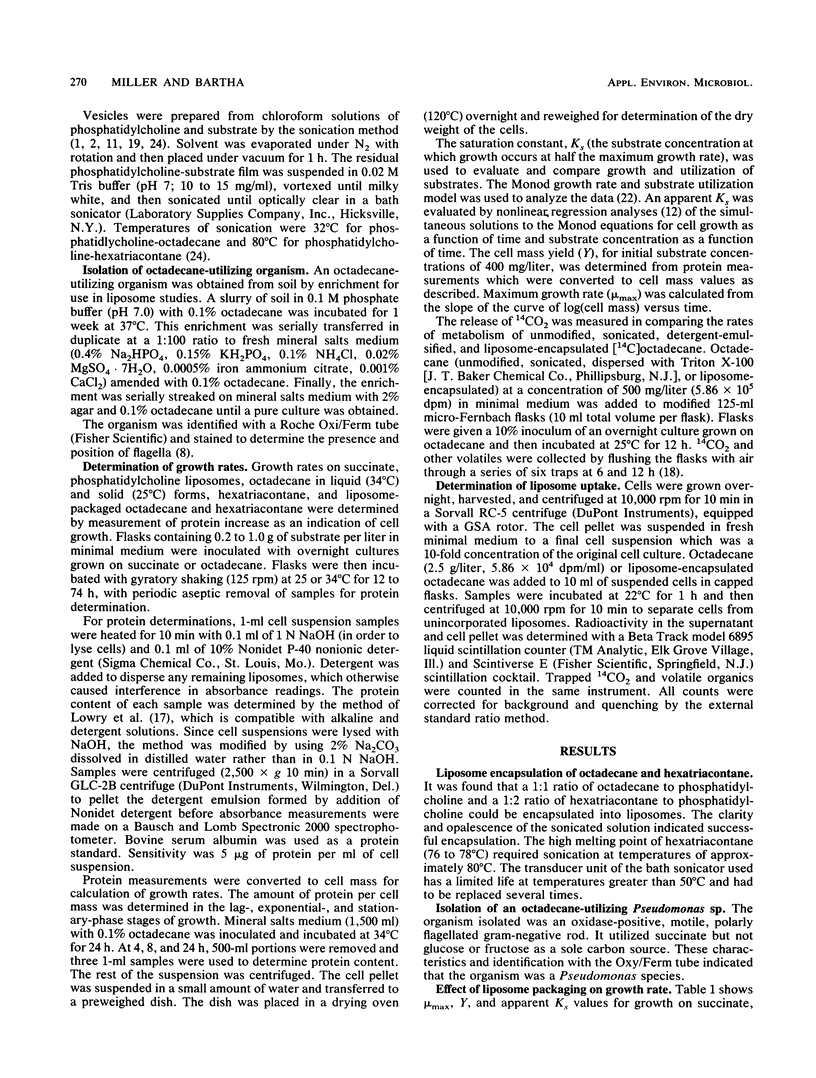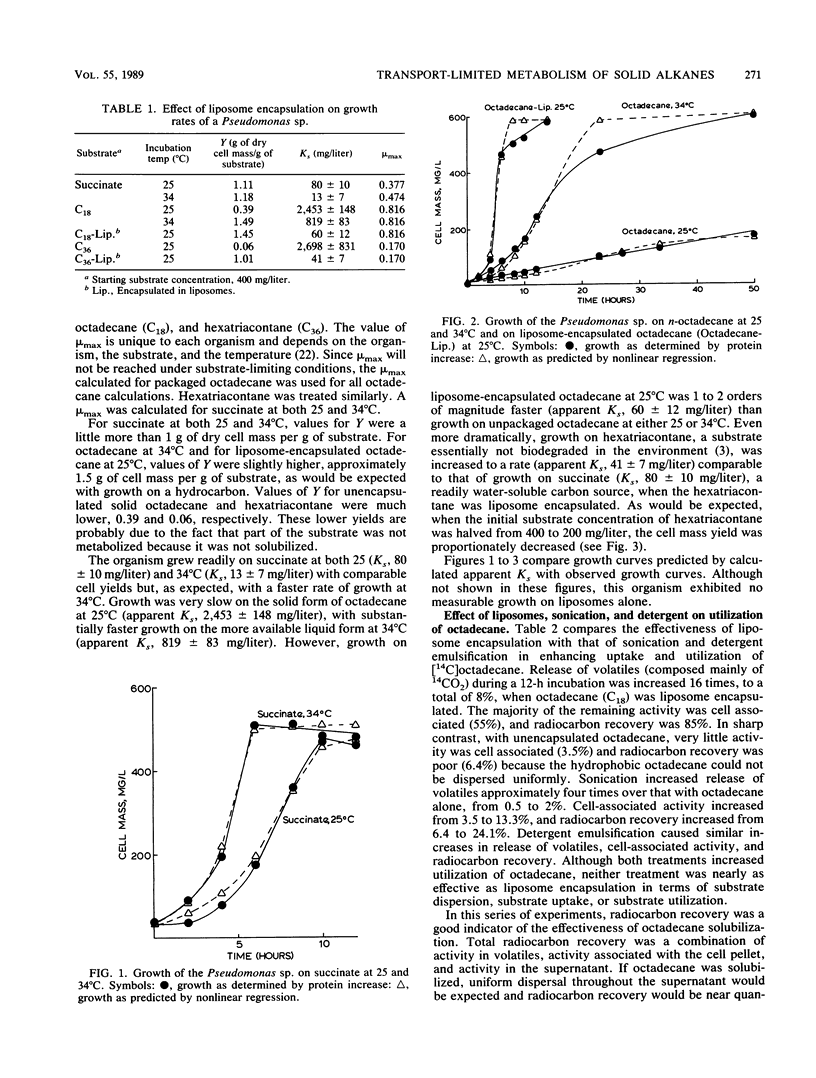Abstract
The recalcitrance of xenobiotics may be caused by an absence of transforming enzymes or by their inability to enter microbial cells. A nondestructive method for differentiating between these two possibilities is described. The solid n-alkanes octadecane (C18) and hexatriacontane (C36) were encapsulated into phosphatidylcholine bilayers (liposomes). The uptake and metabolism rates of encapsulated and unencapsulated substrates were then compared. During 1 h at 25°C, a Pseudomonas isolate took up 1.3% of radiolabeled and unencapsulated C18 (solid state) versus 23.5% of labeled and encapsulated C18. Growth at 25°C occurred with an apparent ks of 2453 ± 148 mg/liter. Liposome encapsulation decreased this Ks to 60 ± 12 mg/liter. At 34°C, growth on C18 (liquid state) occurred with an apparent Ks of 819 ± 83 mg/liter and on the readily available carbon source succinate, Ks values were 80 ± 10 and 13 ± 7 mg/liter at 25 and 34°C, respectively. At 25°C, the isolate grew on C36 with an apparent Ks of 2,698 ± 831 mg/liter. Liposome encapsulation decreased the Ks more than 60-fold to 41 ± 7 mg/liter, resulting in the complete utilization of 400 mg of C36 per liter in 16 h. Since controls excluded the metabolic utilization of phosphatidylcholine, the results clearly identify transport limitation as the cause for C36 recalcitrance.
Full text
PDF





Selected References
These references are in PubMed. This may not be the complete list of references from this article.
- Cofone L., Jr, Walker J. D., Cooney J. J. Utilization of hydrocarbons by Cladosporium resinae. J Gen Microbiol. 1973 May;76(1):243–246. doi: 10.1099/00221287-76-1-243. [DOI] [PubMed] [Google Scholar]
- Fendler J. H., Romero A. Liposomes as drug carriers. Life Sci. 1977 Apr 1;20(7):1109–1120. doi: 10.1016/0024-3205(77)90481-7. [DOI] [PubMed] [Google Scholar]
- Flewelling R. F., Hubbell W. L. Hydrophobic ion interactions with membranes. Thermodynamic analysis of tetraphenylphosphonium binding to vesicles. Biophys J. 1986 Feb;49(2):531–540. doi: 10.1016/S0006-3495(86)83663-3. [DOI] [PMC free article] [PubMed] [Google Scholar]
- Fraley R. T., Fornari C. S., Kaplan S. Entrapment of a bacterial plasmid in phospholipid vesicles: potential for gene transfer. Proc Natl Acad Sci U S A. 1979 Jul;76(7):3348–3352. doi: 10.1073/pnas.76.7.3348. [DOI] [PMC free article] [PubMed] [Google Scholar]
- Gray P. H. A METHOD OF STAINING BACTERIAL FLAGELLA. J Bacteriol. 1926 Oct;12(4):273–274. doi: 10.1128/jb.12.4.273-274.1926. [DOI] [PMC free article] [PubMed] [Google Scholar]
- Huang C. Studies on phosphatidylcholine vesicles. Formation and physical characteristics. Biochemistry. 1969 Jan;8(1):344–352. doi: 10.1021/bi00829a048. [DOI] [PubMed] [Google Scholar]
- Jones N. C., Osborn M. J. Interaction of Salmonella typhimurium with phospholipid vesicles. Incorporation of exogenous lipids into intact cells. J Biol Chem. 1977 Oct 25;252(20):7398–7404. [PubMed] [Google Scholar]
- Jones N. C., Osborn M. J. Translocation of phospholipids between the outer and inner membranes of Salmonella typhimurium. J Biol Chem. 1977 Oct 25;252(20):7405–7412. [PubMed] [Google Scholar]
- LOWRY O. H., ROSEBROUGH N. J., FARR A. L., RANDALL R. J. Protein measurement with the Folin phenol reagent. J Biol Chem. 1951 Nov;193(1):265–275. [PubMed] [Google Scholar]
- Marinucci A. C., Bartha R. Apparatus for monitoring the mineralization of volatile C-labeled compounds. Appl Environ Microbiol. 1979 Nov;38(5):1020–1022. doi: 10.1128/aem.38.5.1020-1022.1979. [DOI] [PMC free article] [PubMed] [Google Scholar]
- Mayer L. D., Bally M. B., Hope M. J., Cullis P. R. Techniques for encapsulating bioactive agents into liposomes. Chem Phys Lipids. 1986 Jun-Jul;40(2-4):333–345. doi: 10.1016/0009-3084(86)90077-0. [DOI] [PubMed] [Google Scholar]
- Osborn M. J., Gander J. E., Parisi E., Carson J. Mechanism of assembly of the outer membrane of Salmonella typhimurium. Isolation and characterization of cytoplasmic and outer membrane. J Biol Chem. 1972 Jun 25;247(12):3962–3972. [PubMed] [Google Scholar]
- Szoka F., Jr, Papahadjopoulos D. Comparative properties and methods of preparation of lipid vesicles (liposomes). Annu Rev Biophys Bioeng. 1980;9:467–508. doi: 10.1146/annurev.bb.09.060180.002343. [DOI] [PubMed] [Google Scholar]


